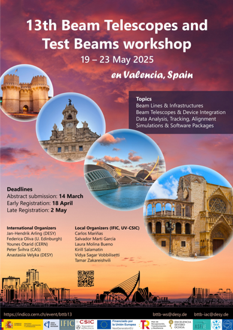Speaker
Description
During the LHC Long Shutdown 3, the ALICE experiment will replace the three innermost layers of the current Inner Tracking System with three truly-cylindrical, ultra-light layers constituted by bent wafer-scale Monolithic Active Pixel Sensors (MAPS) realized in 65 nm CMOS technology through stitching technique.
The first ITS3 sensor prototypes were produced in the Engineering Run 1 in 2023. The babyMOSS chip is one single Repeated Sensor Unit (RSU), i.e. the base modular unit repeated by stitching in the MOnolithic Stitched Sensor (MOSS) prototype, manufactured for characterization and irradiation studies.
The babyMOSS chip has an area of about 30$\times$14 mm$^2$ and the pixel array is divided into two independent Half Units (HUs) with different pixel pitches: 22.5 $\mu m$ for the top HU and 18 $\mu m$ for the bottom HU. Both HUs consist of four regions that implement different front-end electronics flavours.
This poster shows the results from the test beam on babyMOSS chips performed in September 2024 at the CERN PS with a telescope composed of six babyMOSS tracking planes. In this experiment, three babyMOSS chips were tested: one non-irradiated and two irradiated to 10$^{13}$ 1 MeV n$_{eq}$/cm$^2$, which is above the expected ITS3 radiation load.
The analysis is carried out using the Corryvreckan software, a CERN standard tool for test beam data analysis. A detailed description of the analysis workflow is provided, highlighting how geometry definition, alignment, and track reconstruction are performed to get to residual distribution and efficiency evaluation.
The results for the three Devices Under Test are presented, focusing on the performance in terms of efficiency, spatial resolution, and fake hit rate. For both non-irradiated and irradiated DUTs, there is a valid operating range in terms of threshold that satisfy the ITS3 requirements for efficiency and fake hit rate, i.e. above 99% and below 10$^{-6}$ hits/pixel/event respectively.
